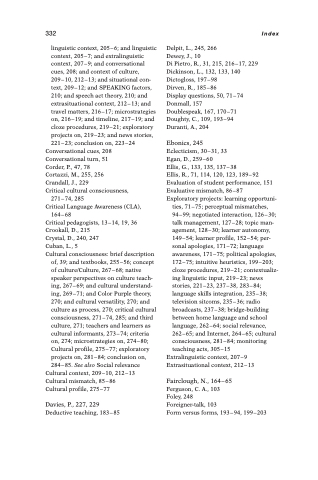Page 344 - Beyond Methods
P. 344
332
Index
linguistic context, 205–6; and linguistic context, 205–7; and extralinguistic context, 207–9; and conversational cues, 208; and context of culture, 209–10, 212–13; and situational con- text, 209–12; and SPEAKING factors, 210; and speech act theory, 210; and extrasituational context, 212–13; and travel matters, 216–17; microstrategies on, 216–19; and timeline, 217–19; and cloze procedures, 219–21; exploratory projects on, 219–23; and news stories, 221–23; conclusion on, 223–24
Conversational cues, 208 Conversational turn, 51 Corder, P., 47, 78 Cortazzi, M., 255, 256 Crandall, J., 229
Critical cultural consciousness, 271–74, 285
Critical Language Awareness (CLA), 164–68
Critical pedagogists, 13–14, 19, 36 Crookall, D., 215
Crystal, D., 240, 247
Cuban, L., 5
Cultural consciousness: brief description of, 39; and textbooks, 255–56; concept of culture/Culture, 267–68; native speaker perspectives on culture teach- ing, 267–69; and cultural understand- ing, 269–71; and Color Purple theory, 270; and cultural versatility, 270; and culture as process, 270; critical cultural consciousness, 271–74, 285; and third culture, 271; teachers and learners as cultural informants, 273–74; criteria on, 274; microstrategies on, 274–80; Cultural profile, 275–77; exploratory projects on, 281–84; conclusion on, 284–85. See also Social relevance
Cultural context, 209–10, 212–13 Cultural mismatch, 85–86 Cultural profile, 275–77
Davies, P., 227, 229 Deductive teaching, 183–85
Delpit, L., 245, 266
Dewey, J., 10
Di Pietro, R., 31, 215, 216–17, 229 Dickinson, L., 132, 133, 140 Dictogloss, 197–98
Dirven, R., 185–86
Display questions, 50, 71–74 Donmall, 157
Doublespeak, 167, 170–71 Doughty, C., 109, 193–94
Duranti, A., 204
Ebonics, 245
Eclecticism, 30–31, 33
Egan, D., 259–60
Ellis, G., 133, 135, 137–38
Ellis, R., 71, 114, 120, 123, 189–92 Evaluation of student performance, 151 Evaluative mismatch, 86–87
Exploratory projects: learning opportuni-
ties, 71–75; perceptual mismatches, 94–99; negotiated interaction, 126–30; talk management, 127–28; topic man- agement, 128–30; learner autonomy, 149–54; learner profile, 152–54; per- sonal apologies, 171–72; language awareness, 171–75; political apologies, 172–75; intuitive heuristics, 199–203; cloze procedures, 219–21; contextualiz- ing linguistic input, 219–23; news stories, 221–23, 237–38, 283–84; language skills integration, 235–38; television sitcoms, 235–36; radio broadcasts, 237–38; bridge-building between home language and school language, 262–64; social relevance, 262–65; and Internet, 264–65; cultural consciousness, 281–84; monitoring teaching acts, 305–15
Extralinguistic context, 207–9 Extrasituational context, 212–13
Fairclough, N., 164–65
Ferguson, C. A., 103
Foley, 248
Foreigner-talk, 103
Form versus forms, 193–94, 199–203


